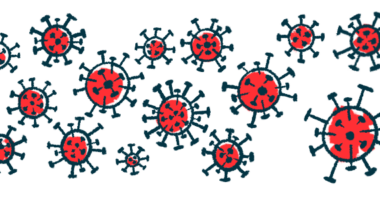EBV vaccine expected to be cost-effective in preventing MS: Study
Researchers looked at giving vaccination at birth and age 12

Using a vaccine against the Epstein-Barr virus (EBV) to prevent the development of multiple sclerosis (MS) is highly likely to be cost-effective, especially when given in early adolescence, according to an Australian modeling study.
“The evidence from this study highlights the urgent need for the development of an EBV vaccine, and it identifies a potentially preferential vaccination strategy targeting young adolescents,” the researchers wrote.
The modeling study, “Exploring the cost-effectiveness of EBV vaccination to prevent multiple sclerosis in an Australian setting,” was published in the Journal of Neurology, Neurosurgery and Psychiatry.
EBV is a common virus and the leading cause of infectious mononucleosis (commonly known as mono), infecting more than 90% of humans in the course of their lives. In most cases, patients experience only unspecific symptoms such as fatigue and fever, or no symptoms at all, after infection.
Emerging evidence indicates that infection with EBV is a prerequisite for developing MS, an autoimmune disease characterized by inflammation and damage in the brain and spinal cord.
Therefore, a vaccine that provides immunity against EBV can potentially prevent MS. While no EBV vaccine has been approved so far, clinical trials evaluating investigational vaccines are underway.
Researchers examine costs of hypothetical EBV vaccine
Because of its potential for disease prevention, an EBV vaccine is likely to provide substantial savings in costs otherwise spent in managing MS. Direct MS costs include those for medications and consultations, hospitalizations, emergency room visits, nursing homes, home modifications, and transportation. In turn, indirect costs come from financial loses due to limited working abilities.
In advance of an effective EBV vaccine, researchers in Australia created computer models to explore the cost-effectiveness of a hypothetical EBV vaccine that would prevent MS.
“Our objective was to develop a long-term simulation model of the incidence and progression of MS in an Australian setting to explore the cost-effectiveness of MS prevention with a hypothetical EBV vaccination,” the researchers wrote.
The team developed a model that incorporated estimates of medical costs sourced from an Australian government report on total health expenditures. Vaccine efficacy was estimated at 78% based on a previous Phase 2 clinical trial. Vaccine costs were based on other vaccines, ranging from Australian dollar (AU) $50 to $269.99 per dose (U.S. $32 to $175).
Two potential vaccine strategies were assessed: either given as part of routine infant vaccination programs in the first year of life before EBV exposure or at age 12 to prevent infectious mononucleosis, which typically occurs between the ages of 15 and 19.
Calculated outcomes included total lifetime costs and quality-adjusted life years (QALY), with or without EBV vaccination. QALY is a measure of disease burden that considers the quality of life and the number of years lived; for example, one QALY equates to one year in perfect health.
In this study, the QALY was discounted by 5%, which means future health outcomes are valued at 5% less than present health outcomes.
In infancy, vaccination led to a reduction of AU$40 ($26) in total direct and indirect lifetime costs and 0.003 higher QALYs than without vaccination. In this scenario, vaccination would save AU$1,017,000,000 ($660,297,420) and gain 76,268 QALYs when extrapolated to the entire Australian population of about 25 million (in 2021). Here, there was a 66% chance that vaccination would be cost-effective compared with no vaccination.
In comparison, vaccination at the age of 12 led to even lower direct and indirect lifetime costs — a reduction of AU$452 ($293) — and higher QALYs (0.007 QALY gains) versus the group that was not vaccinated. Vaccination would save about AU$11,490,000,000 ($7,459,997,400) and gain 177,940 QALYs in this setting. The likelihood of vaccine cost-effectiveness versus no vaccine was 90%.
When only direct costs were included in the model, the infant vaccination group had 0.004 QALY gains but higher total lifetime costs of AU$238 ($155) compared with no vaccination. Despite gains in QALYs, vaccinations across Australia would cost AU$6,049,000,000 ($3,927,373,740) more than no vaccination, with a cost-effectiveness of 36%.
The direct lifetime cost associated with vaccination at age 12 also was higher, at AU$104 ($68) per person, and led to 0.006 QALY gains. Here, vaccinations would cost AU$2,644,000,000 ($1,716,643,440) more than no vaccination, with a cost-effectiveness of 77%.
Reduction of MS incidence also component of study
A statistical analysis found that if the vaccination costs AU$175 ($114) per person, infant vaccination would be cost-effective when MS incidence was reduced by 17% or more. If an EBV vaccine reduced MS incidence by 96%, infant vaccination would be cost-effective if vaccination costs were less than AU$994 ($645) per person (based on two doses).
Using the same vaccine cost, vaccination at age 12 would be cost-effective when MS incidence was reduced by 10% or more. If a vaccine reduced MS incidence by 96%, adolescent vaccination would be cost-effective if the vaccine costs were less than AU$1,923 ($1,249) per person.
“MS prevention using future EBV vaccinations as part of a standard immunisation programme, especially targeted to an adolescence population, is likely to be highly cost-effective even under conservative model assumptions,” the researchers concluded. “Future studies are recommended to validate our exploratory results using improved estimates of costs and efficacy of EBV vaccine and its extended beneficial and possible harmful effects in the models.”







